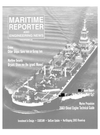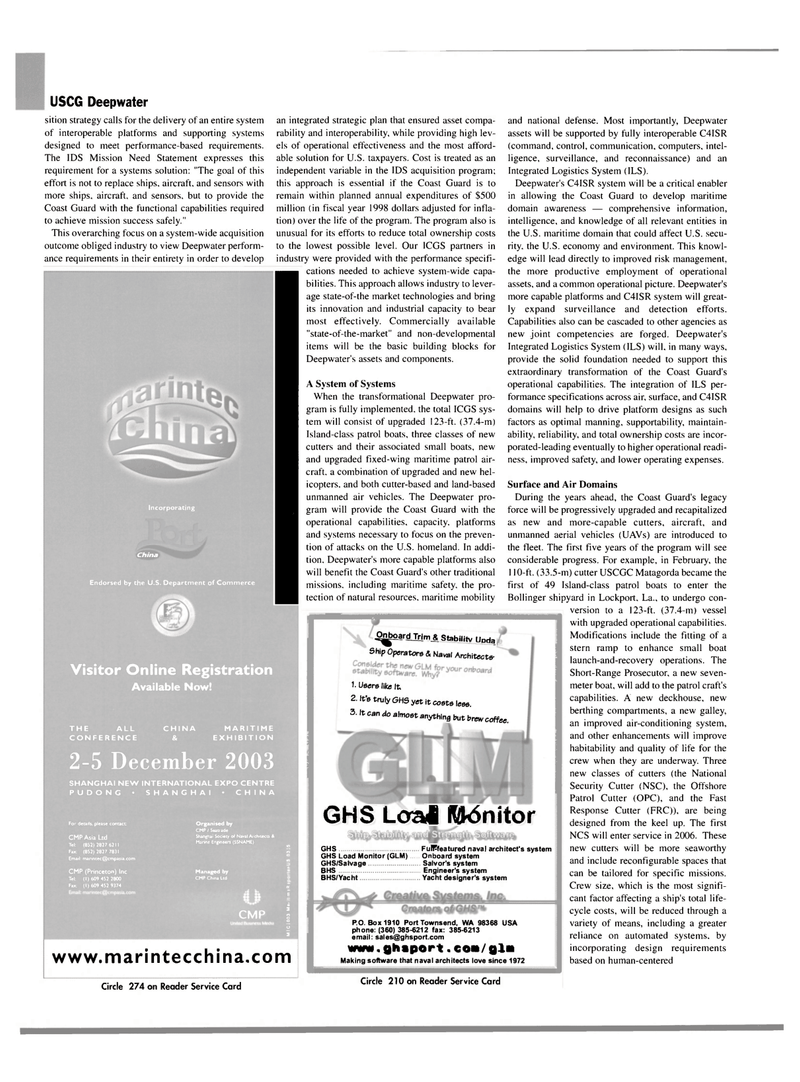
Page 20: of Maritime Reporter Magazine (July 2003)
Read this page in Pdf, Flash or Html5 edition of July 2003 Maritime Reporter Magazine
USCG Deepwater sition strategy calls for the delivery of an entire system of interoperable platforms and supporting systems designed to meet performance-based requirements.
The IDS Mission Need Statement expresses this requirement for a systems solution: "The goal of this effort is not to replace ships, aircraft, and sensors with more ships, aircraft, and sensors, but to provide the
Coast Guard with the functional capabilities required to achieve mission success safely."
This overarching focus on a system-wide acquisition outcome obliged industry to view Deepwater perform- ance requirements in their entirety in order to develop
Incorporating
China
Endorsed by the U.S. Department of Commerce
Visitor Online Registration
Available Now!
THE ALL CHINA MARITIME
CONFERENCE & EXHIBITION 2-5 December 2003
SHANGHAI NEW INTERNATIONAL EXPO CENTRE
PUDONG • SHANGHAI • CHINA
For details, please contact: Organised by
CMP / Seatrade
CMP Asia Ltd Shanghai Society of Naval Architects &
Tel: <851) 2827 6211
Fax: <852) 282? 7831
Email: [email protected]
CMP (Princeton) Inc Managed by
Tel: Fax: (I) 609 452 937-4
CMP
an integrated strategic plan that ensured asset compa-
rability and interoperability, while providing high lev-
els of operational effectiveness and the most afford-
able solution for U.S. taxpayers. Cost is treated as an
independent variable in the IDS acquisition program;
this approach is essential if the Coast Guard is to
remain within planned annual expenditures of $500
million (in fiscal year 1998 dollars adjusted for infla-
tion) over the life of the program. The program also is
unusual for its efforts to reduce total ownership costs
to the lowest possible level. Our 1CGS partners in
industry were provided with the performance specifi-I
cations needed to achieve system-wide capa-
bilities. This approach allows industry to lever-
age state-of-the market technologies and bring
its innovation and industrial capacity to bear
most effectively. Commercially available
"state-of-the-market" and non-developmental
items will be the basic building blocks for
Deepwater's assets and components.
A System of Systems
When the transformational Deepwater pro-
gram is fully implemented, the total ICGS sys-
tem will consist of upgraded 123-ft. (37.4-m)
Island-class patrol boats, three classes of new
cutters and their associated small boats, new
and upgraded fixed-wing maritime patrol air-
craft, a combination of upgraded and new hel-
icopters. and both cutter-based and land-based
unmanned air vehicles. The Deepwater pro-
gram will provide the Coast Guard with the
operational capabilities, capacity, platforms
and systems necessary to focus on the preven-
tion of attacks on the U.S. homeland. In addi-
tion. Deepwater's more capable platforms also
will benefit the Coast Guard's other traditional
missions, including maritime safety, the pro-
tection of natural resources, maritime mobility
m n
o v>
«r
E
<5 2
M ©
o
O
2
and national defense. Most importantly, Deepwater
assets will be supported by fully interoperable C4ISR
(command, control, communication, computers, intel-
ligence, surveillance, and reconnaissance) and an
Integrated Logistics System (ILS).
Deepwater's C4ISR system will be a critical enabler
in allowing the Coast Guard to develop maritime
domain awareness — comprehensive information,
intelligence, and knowledge of all relevant entities in
the U.S. maritime domain that could affect U.S. secu-
rity. the U.S. economy and environment. This knowl-
edge will lead directly to improved risk management,
the more productive employment of operational
assets, and a common operational picture. Deepwater's
more capable platforms and C4ISR system will great-
ly expand surveillance and detection efforts.
Capabilities also can be cascaded to other agencies as
new joint competencies are forged. Deepwater's
Integrated Logistics System (ILS) will, in many ways,
provide the solid foundation needed to support this
extraordinary transformation of the Coast Guard's
operational capabilities. The integration of ILS per-
formance specifications across air, surface, and C4ISR
domains will help to drive platform designs as such
factors as optimal manning, supportability, maintain-
ability, reliability, and total ownership costs are incor-
porated-leading eventually to higher operational readi-
ness, improved safety, and lower operating expenses.
Surface and Air Domains
During the years ahead, the Coast Guard's legacy
force will be progressively upgraded and recapitalized
as new and more-capable cutters, aircraft, and
unmanned aerial vehicles (UAVs) are introduced to
the fleet. The first five years of the program will see
considerable progress. For example, in February, the
110-ft. (33.5-m) cutter USCGC Matagorda became the
first of 49 Island-class patrol boats to enter the
Bollinger shipyard in Lockport. La., to undergo con-
version to a 123-ft. (37.4-m) vessel
with upgraded operational capabilities.
Modifications include the fitting of a
stern ramp to enhance small boat
launch-and-recovery operations. The
Short-Range Prosecutor, a new seven-
meter boat, will add to the patrol craft's
capabilities. A new deckhouse, new
berthing compartments, a new galley,
an improved air-conditioning system,
and other enhancements will improve
habitability and quality of life for the
crew when they are underway. Three
new classes of cutters (the National
Security Cutter (NSC), the Offshore
Patrol Cutter (OPC), and the Fast
Response Cutter (FRC)), are being
designed from the keel up. The first
NCS will enter service in 2006. These
new cutters will be more seaworthy
and include reconfigurable spaces that
can be tailored for specific missions.
Crew size, which is the most signifi-
cant factor affecting a ship's total life-
cycle costs, will be reduced through a
variety of means, including a greater
reliance on automated systems, by
incorporating design requirements
based on human-centered
•^arOimASfabintyJ^
Ship Operators & Naval Architects-
1. Users like It
2. It's truly GHS yet it costs less.
3. It can do almost anything but brew coffee.
GHS Loali Monitor
GHS FulPfeatured naval architect's system
GHS Load Monitor (GLM) Onboard system
GHS/Salvage Salvor's system
BHS Engineer's system
BHS/Yacht Yacht designer's system
www.marintecchina.com
P.O. Box 1910 Port Townsend, WA 98368 USA
phone: (360) 385-6212 fax: 385-6213
email: [email protected]
wtm.ghaport.COM/gla
Making software that naval architects love since 1972
Circle 274 on Reader Service Card Circle 210 on Reader Service Card

 19
19

 21
21
